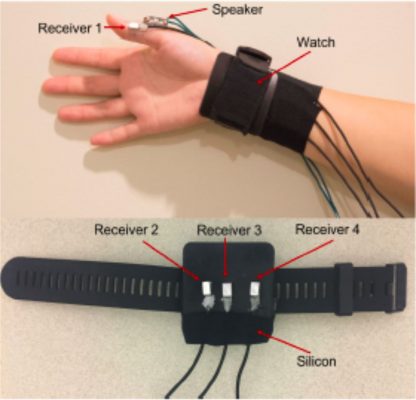A ring-wristband combination that reads hand poses could one day be used to control a device or write text discreetly while carrying on a conversation.
The technology is called FingerPing and was developed at Georgia Institute of Technology (Georgia Tech) in Atlanta.

A presentation and scientific paper about it featured recently at the 2018 Association for Computing Machinery (ACM) CHI Conference on Human Factors in Computing Systems in Montreal, Canada.
The “proof of concept” research establishes the feasibility of the technique, which can now be developed further.
Unobtrusive wearable
The ring-wristband system is different to other solutions in that it does not require an obtrusive wearable like a glove.
It has just a thumb ring and a wristband, which can be incorporated into a wristwatch.
The idea is to allow users to operate smart technology in an inconspicuous way with a few subtle hand movements.
These might be used, for example, to start or stop a music track, or to enter numbers and text into a T9 keyboard, such as that of a mobile phone.
“Some interaction is not socially appropriate,” says first author of the study paper Dr. Cheng Zhang, who is moving on from Georgia Tech’s School of Interactive Computing to take up an assistant professorship in information science at Cornell University in Ithaca, NY.
A user should be able to interact with their wearable “at any time in an appropriate and discreet fashion,” states Dr. Zhang.
“When we’re talking,” he adds, “I can still make some quick reply that doesn’t interrupt our interaction.”
‘Acoustic chirps’
The ring generates special sound waves known as “acoustic chirps” that travel inside the hand to receivers in the wristband.
The pattern of sound waves in the chirps can be altered by assuming small hand poses, such as tapping a finger-tip or making classic 1-2-3 gestures.
The receiver in the wristband “recognizes these tiny differences,” Dr. Zhang explains.
“The injected sound from the thumb,” he continues, “will travel at different paths inside the body with different hand postures. For instance, when your hand is open there is only one direct path from the thumb to the wrist.”
Device recognizes 22 hand poses
When a hand gesture closes a loop, the sound travels along a different path and creates a “unique signature.”
The current version of the ring-wristband can read 22 different “fine-grained hand poses.”
Dr. Zhang says that they are also developing the device to recognize American Sign Language. Such a system would be less cumbersome than other techniques that rely on cameras to read the gestures.
Video demonstration
The following video from ACM demonstrates the ring-wristband that was presented at the conference.
